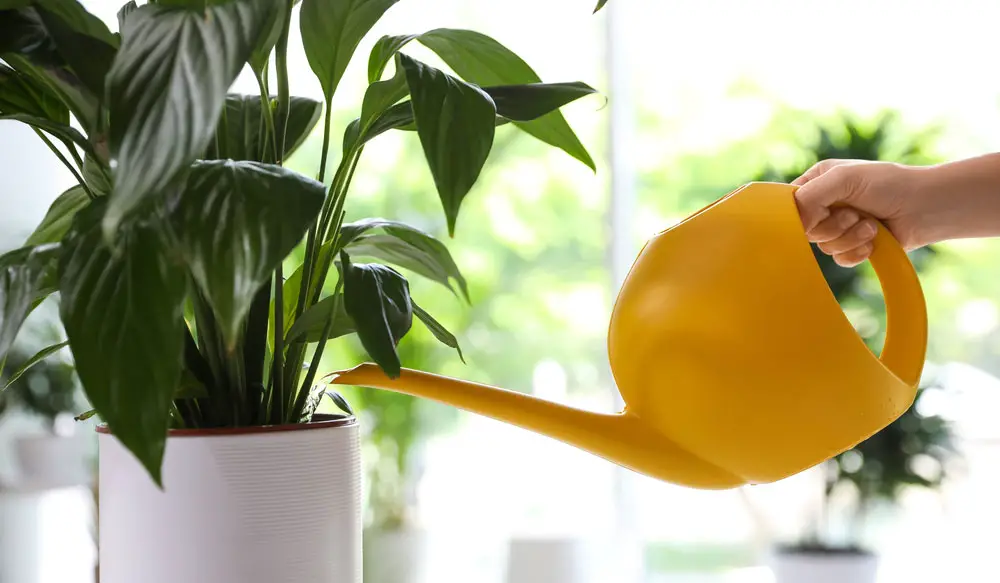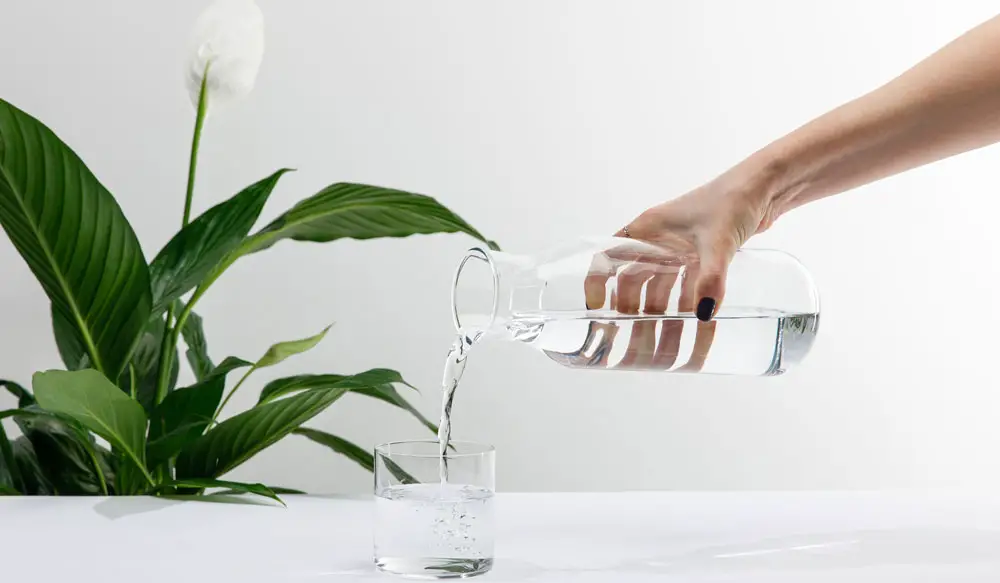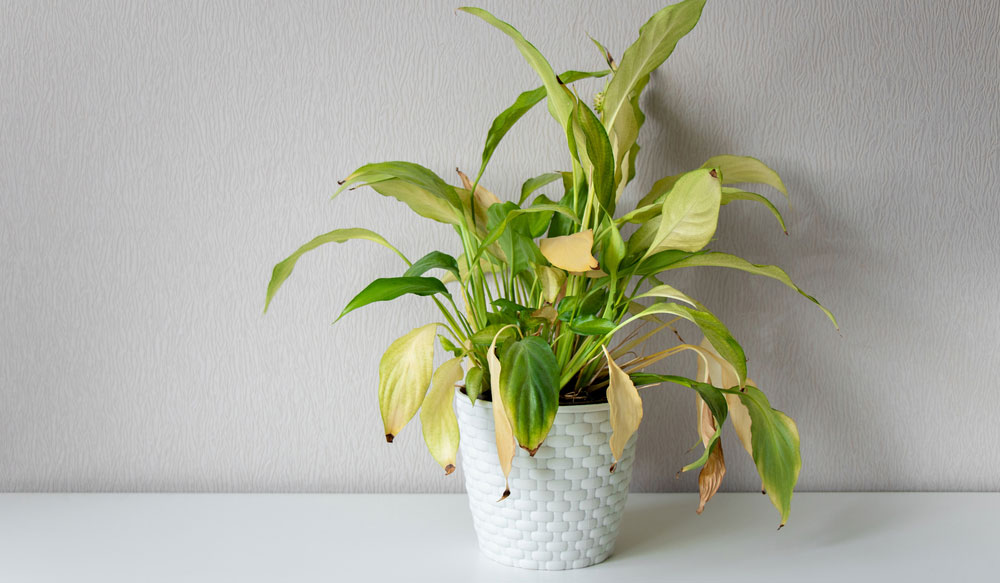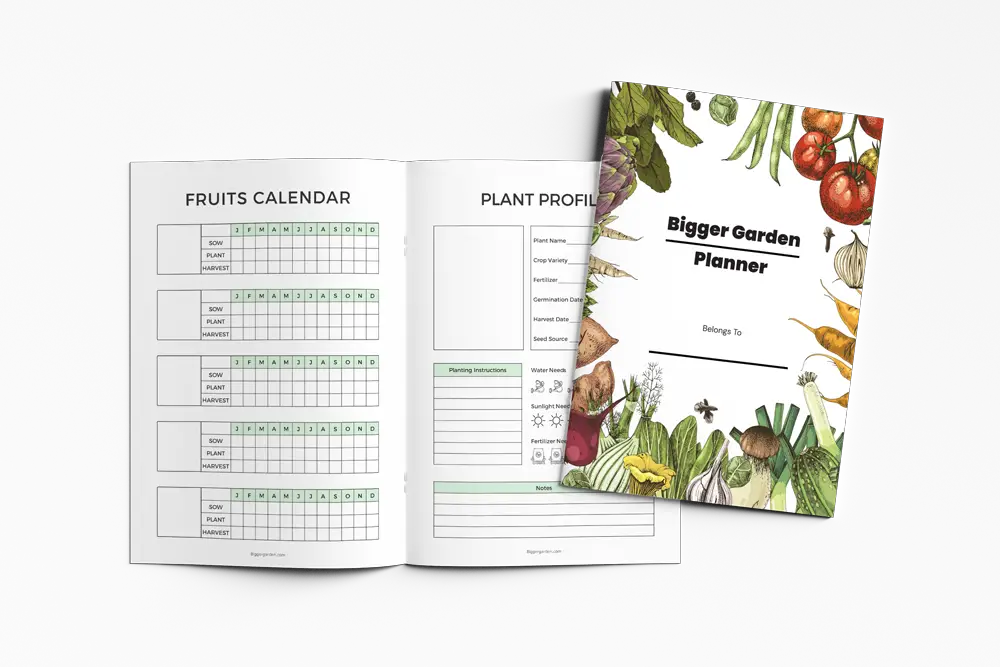How Much Water Do Peace Lilies Need?

This post follows our research editorial guidelines.

Watering a peace lily (Spathiphyllum) is probably the trickiest part of its care, and the easiest step to get wrong. It’s a rite of passage to one day be greeted by a limp thirsty lily or to trim dead leaves from one struggling with in a sodden pot. But I’ve worked out a few tricks and tactics to keep these luscious lilies looking their best, and I’m happy to share them.
Peace lilies need to be kept consistently moist without being soggy or sodden. They also require water free of chemical additives or salts. Water deeply and allow the soil to dry out before watering again.

Table of Contents
How Often to Water Peace Lilies
In general, it’s best to check the soil before watering. Peace lilies like to have soil that’s well hydrated without becoming sodden. To achieve this, water when the soil starts to dry. It could be as much as once or twice a week in summer, or once a month in winter.
That said, plants don’t work to a schedule, and their environment will influence how often they need to be watered. Warm temperatures cause the soil to dry out faster, in addition to the extra used by the lily when growing conditions are good. A well lit plant will grow faster, and need more water, than one in the shade. Dry air, like that caused by HVAC systems, also result in peace lilies that want more water.
Just wait for the soil to dry first. It’s the best way to prevent over-watering. If you’d like to be sure, you can always use an electric water meter to monitor your soil conditions. It’ll give you a reliable indicator of when to water.
How to Tell if your Peace Lily is Over Watered
“Peace lilies do not like to be kept constantly wet. Over-watering can result in the roots rotting followed by wilting of the plant. If the container is sitting in a pan or saucer that collects the water that drains out, and that water isn’t poured off after an hour, the soil remains too saturated. The soil should be allowed to dry to the touch before you water again.” Quote: James Schmidt, Extension specialist Department of Crop Sciences at the University of Illinois.
Unresponsive Drooping Peace Lily Leaves
Drooping leaves in a dehydrated peace lily spring back in as little as a few hours when watered. But this is not the case for one with too much water in the pot.
Roots need pockets of air to function properly, and a pot with too much water in it stresses the whole system. The roots stop functioning, and can no longer take water to the leaves. Presto! Drooping leaves, despite a torrent in the pot.
Water Damaged Peace Lily Leaves
Leaf changes are the other giveaway. Over-watered leaves fade to yellow in blotches, with brown soggy patches to follow. These areas are less crisp, softer in general and almost spongy towards the base of the stem. The leaves may also develop oedema, a blister of sorts filled with clear liquid. If burst they soon dry out, becoming crusty or dried out.
How to Tell if your Peace Lily is Under Watered
Drooping Peace Lily Leaves
Peace lilies will let you know if they’re feeling thirsty by drooping their leaves. It can be quite dramatic to see a lily that’s usually lush and thick suddenly flop over like a handful of boiled fettuccine.
Water serves many functions for the lily, and one of them is providing structural support. When the cells inside the leaves are well hydrated, they plump out and become rigid. The pressure that holds the cells taunt is called turgor pressure. Once the water goes, so does the structural support and the leaves will droop.
Crisp Peace Lily Leaves
The other big sign is changes to the color and texture of the leaves. Consistently under-watered leaves will in time turn yellow or brown, especially around the tips of the leaves. They’ll become crisp and papery to the touch, sometimes flaking away.
When to water a peace lily
It’s best to water in the mornings where possible, as it gives the peace lily a good foundation to start its day. Avoid watering late in the day or after dark. Peace lilies are prone to pouting when their roots are cold, and they really won’t get much use out of that water overnight. It’ll just sit there, making the lily feel chilly.

How to water a peace lily
There’s two great approaches to watering a peace lily: watering from above, and watering from below. No matter what technique you opt for, make sure the water is room temperature. You also need to make sure that drip trays or saucers remain empty even after a watering. Peace lilies hate having wet feet.
How to water a peace lily from below
Watering from above is exactly as it sounds – pour water into the pot from the top, a classic approach that conjures images of cute watering cans sprinkling a rain-like abundance on your grateful lily. It’s not too far off!
To water from above add water to the soil from the top of the pot, really drenching the lot. Keep going until you have a decent flow running from the drainage holes. This ensures the soil is really drenched, top to bottom. Allow the peace lily to drain, then return it to its saucer or tray.
How to water a peace lily from below
To water from below, remove your peace lily from its saucer or tray and place in a large basin or tub. It needs to be at least half as deep as the peace lily’s pot is tall. Once the plant is in place, add clean water to the basin, holding the peace lily stable. Water will seep into the pot through the drainage holes. Add more water until the level is halfway up the side of the lily’s pot.
Once that’s done, it’s just a matter of waiting. 15 minutes to half an hour is ideal, depending on how thirsty your plant is. A drooping peace lily can be treated to a half hour at least, giving it time to draw water into the leaves. After that unit of time has elapsed, take it from the basin and allow to drain.
Watering Tips:
Best type of water for a peace lily
Peace lilies are chemically sensitive. They need quite pure water to thrive.
This means for most of us, tap water is right out. Municipal water often contains chlorine to kill bacteria or fluoride to protect teeth. Furthermore most tap water is quite ‘hard’, full of mineral salts that can build up in the soil and damage the lily’s delicate roots.
Rainwater is best for lilies. Some folks collect rainwater and store it in bottles for later use. Personally that’s more effort than I’m willing to put in, so instead I use filtered water. A cartridge style filter jug pulls out pretty much all the hazardous chemicals from the water, leaving just the good stuff for my peace lilies. You can also opt to use distilled water, too.

Best Water Temperature for a peace lily
Now onto the real fussy bits – peace lilies really don’t like cold water on their roots. And who can blame them? I don’t like a cold shower either! It won’t kill them, but over time cold roots will stunt their growth and result in an overall less vigorous plant.
Room temperature is best. I leave my jug on a counter until it’s tepid, but you can cheat with a shot of hot water into a watering can in a pinch.
How to add drainage to a pot for better watering
Peace lilies like a well draining medium, rich with lots of organic matter. Most commercial potting blends are fairly good at providing lots of compost, peat or other organics, but you’ll need to cover the drainage part yourself.
For peace lilies, I’d suggest improving the soil by mixing through one part vermiculite to every three parts potting soil. Vermiculite is a mineral that holds moisture while allow excess to flow right past. It doesn’t break down and will provide that support for as long as its in the soil. It’s a great choice for a peace lily.
Perlite is another option. It’s a form of volcanic glass, treated until it puffs up like popcorn. This gives it a lovely airy quality that keeps water flowing through your potting soil. If you’ve lost plants to over-watering in the past, perlite’s best for you.
Of course you’ll need to make sure there’s somewhere for that water to go. Never plant a peace lily in a pot with no drainage holes at the bottom. The more the merrier, and I’d suggest at least three holes for your peace lily’s pot.
Frequently Asked Questions
How often do I water my peace lily in winter?
You may only need to water a peace lily once a month or even less in the winter. It’s always important to check the soil in the pot first. If you’ve got the heat up and good lighting, you may be surprised at just how much growing through the chillier end of the year.

-
What does an over-watered peace lily look like?
An over-watered peace lily is a dismal sight to behold. Leaves will be limp, blotchy and with brown or yellow edges. Stems may turn black and rot, and the leaves sometimes develop oedema blisters.
-
Do you water peace lily from top or bottom?
Surprise, the answer is both! Watering Peace Lilies from above and watering from below have their own benefits and drawbacks, so for best results you can mix and match as needed.
Top watering is convenient and fast, and good at removing buildups of fertilizer or other nasties. Bottom watering results in deeper, more lasting hydration. Water from below once a month during the summer and spring and water from above the rest of the time. It’ll keep your soil fresh and clean, but still keep that deep lasting hydration a peace lily loves.
Why is my peace lily drooping even after watering?
Despite plenty of water drooping Peacy Lily leaves can be the result of overwatering or underwatering. If you’ve done your best to give your droopy peace lily a good drink and it’s still floppy as a car-yard air dancer, it’s worth checking the roots. Limp leaves with wet soil signals root rot, and you may need to trim dead roots and re-pot the plant. Signs of root rot include:
- Soft, browning leaves
- Oedema
- Rotten stems
- Foul odor
- Mildew, mold or visible water on the surface of the soil.
- Brown, slimy roots that break away when touched
Final thoughts
Consider the lily – a bright white flower and a luscious spread of leaves. They may need a bit of work to keep well-watered, but the glorious display of enduring flowers and luxurious foliage make all the fuss worthwhile.
